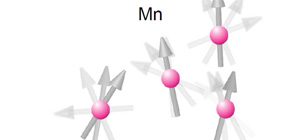
Sensitive detection of magnetic fluctuations with pure spin current
Will lead to magnetic sensors with pure spin current
Spintronics is a new class of electronics where two degrees of freedom of an electron, i.e., charge and spin, are utilized. Thus, understanding spin-dependent transport properties is at the heart of spintronics. A pure spin current, flow of spin angular momentum without charge current, is one of the important physical quantities in the field of spintronics, because it could play an essential role in low energy consumption electronics of the next generation. On the other hand, the pure spin current should also probe some spin properties in a sensitive way since there is no net charge current, but it has not been utilized for such fundamental research so far.
A group of researchers from Osaka University, The University of Tokyo, Centre national de la recherche scientifique, Université Paris-Sud, Japan Atomic Energy Agency, and RIKEN reported that magnetic fluctuations can be detected with pure spin current. To investigate such magnetic fluctuations, spin glass was chosen. The spin glass is a typical frustrated system where a small amount of impurities with magnetic moments is randomly distributed in a nonmagnetic host metal. At high temperatures, the magnetic moments are fluctuating with a very high speed. As the temperature approaches the spin glass temperature T g , the fluctuations become slower and then the magnetic moments are frozen at T g . This has been well studied in many spin glass systems with magnetization measurements.
In this research, the pure spin current was injected into a spin glass system (CuMnBi alloy). An anomaly was observed far above T g . This result indicates that pure spin current can detect fluctuating magnetic moments in a much more sensitive way than conventional magnetization measurements. In the near future, magnetic sensors with pure spin current would be developed and replace the superconducting quantum interference device (SQUID).
Institute for Solid State Physics of the University of Tokyo -- NIIMI Yasuhiro , Assistant Professor (currently Associate Professor, Graduate School of Science, Osaka University), OTANI Yoshichika , Professor
Advanced Science Research Center, Japan Atomic Energy Agency -- MAEKAWA Sadamichi , Director
Abstract
We have measured spin Hall effects in spin glass metals, CuMnBi alloys, with the spin absorption method in the lateral spin valve structure. Far above the spin glass temperature T g where the magnetic moments of Mn impurities are randomly frozen, the spin Hall angle of a CuMnBi ternary alloy is as large as that of a CuBi binary alloy. Surprisingly, however, it starts to decrease at about 4 T g and becomes as little as 7 times smaller at 0.5 T g . A similar tendency was also observed in anomalous Hall effects in the ternary alloys. We propose an explanation in terms of a simple model considering the relative dynamics between the localized moment and the conduction electron spin.

Illustration of spin-charge conversion in a spin glass system (CuMnBi ternary alloy). A pure spin current I S is converted into a charge current I C at the Bi impurity site which has no magnetic moments but converts I S into I C via its strong spin-orbit interaction. Red and blue arrows with green spheres are spins of conduction electrons (| e |) and the shadows indicate that the conduction electron spins are randomized by the localized magnetic moments at the Mn sites. The curved arrows show the motions of spin-up and spin-down electrons.
To learn more about this research, please view the full research report entitled “Strong Suppression of the Spin Hall Effect in the Spin Glass State” at this page of the Physical Review Letters website.
Related link

